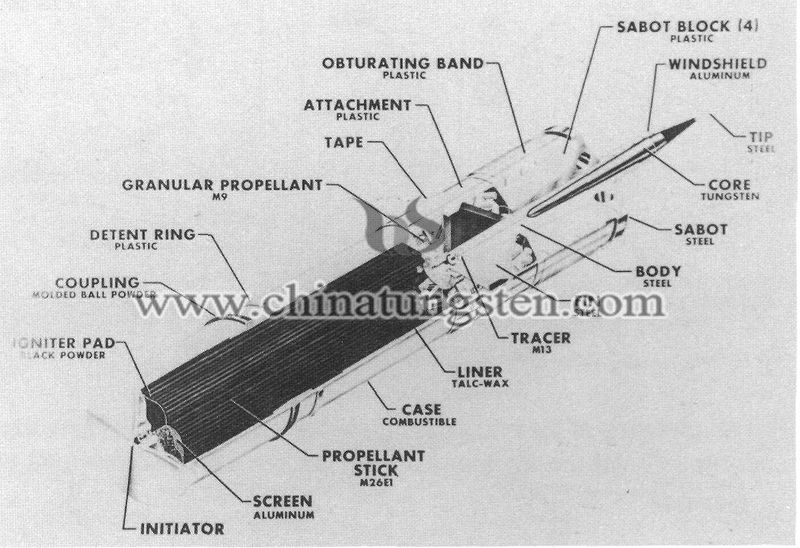Tungsten Alloy for XM578
- Details
- Category: Tungsten Information
- Published on Wednesday, 28 August 2013 18:23
During the late 1950s, tungsten carbide was the primary material used for kinetic energy, armor-piercing projectiles. When first fielded, tungsten carbide represented a quantum improvement over its nearest competitor, high carbon steel. Its higher density (approximately 13 gm/cc) gave it superior penetration performance against existing armor targets. With the advent of double and triple plated armor in the 1960s, however, tungsten munitions showed a tendency to break up before penetrating the layered armor. This deficiency spurred the development of new alloys and materials capable of defeating any armored threats.
In response to the new operational requirements, military developers evaluated a succession of metal alloys. Initially, the British government developed a higher density tungsten alloy consisting of 93 percent tungsten and 7 percent binder tungsten alloy (WA). The new WA alloy had a density of 17 gm/cc -- versus 13 gm/cc for tungsten carbide. From 1965 to 1972, the US Army conducted a parallel development program for the 152mm XM578 cartridge, which was co-developed with the prototype MBT-70 Tank. The XM578 cartridge used a tungsten alloy that was slightly denser than the British alloy, consisting of 97.5 percent tungsten and 2.5 percent binder, which had a density of 18.5 gm/cc.
Picatinny began to research upgrades to the penetrator in the early 1950s. They eventually led to the revolutionary development of accurate, long-rod, fin stabilized penetrators encased in aluminum sabots that filled the full diameter of the inside of the barrel and were capable of defeating the heaviest tank armor. By the mid 1960s, Picatinny's efforts concentrated on a very high pressure, smoothbore cannon in a 120mm caliber and on experimental fin stabilized projectiles. These used a variety of sabot designs and a new penetrating material, depleted uranium (DU). There were difficulties with sabot integrity and excessive gun wear, but the program showed that very high pressures were feasible, that such pressures were essential to greatly improved performance and that DU could be used as a structural material as well as an efficient penetrator.
In the 1960s, tungsten alloys used in the XM578 projectile had to be encased in a steel jacket to withstand the extreme firing velocities of the 152mm gun, reducing the penetrating effectiveness of the tungsten cartridge. The new U-3/4Ti alloy overcame these early limitations for large caliber munitions.
The primary effort at Picatinny during that time period was the development of the XM578 kinetic energy round for the new 152mm cannon. A strategy was devised that called for combining ultra-lightweight plastics with titanium sabot components, with the DU material that acted as both a structural material and as the penetrator body. These were combined with a plastic driving and sealing band that allowed insertion of the much longer KE cartridge several feet down the rifled bore of the new cannon.
From 1965 to 1972, the US Army conducted development program for the 152mm XM578 cartridge, which was co-developed with the prototype MBT-70 Tank. The XM578 cartridge used a tungsten alloy that was slightly denser than the British alloy, consisting of 97.5 percent tungsten and 2.5 percent binder, which had a density of 18.5 gm/cc. The tungsten alloys used in the XM578 projectile had to be encased in a steel jacket to withstand the extreme firing velocities of the 152mm gun, reducing the penetrating effectiveness of the tungsten cartridge.
A strategy was devised that called for combining ultra-lightweight plastics with titanium sabot components. These were combined with a plastic driving and sealing band that allowed insertion of the much longer KE cartridge several feet down the rifled bore of the new cannon.
With the terminatlon of the Program and the initiation of the XM-1 Tank Program, a need for a modern 105mm Anti-tank, Kinetic Energy Projectile. Picatlnny Arsenal responded to this tasking by utilizing the technology gained in the 152nwn Program - specifically the subpEojectile - and adapting it to the 105mm Gun by means of a saddle sabot.
Throughout the 1960s and early 1970s, the US Army developed a successive series of improved 105mm rounds (the primary caliber of the main gun on M-60 and developmental XM-1 series tanks) using the denser 97.5 percent tungsten alloy. The XM735 and XM774 cartridges were the first rounds developed out of the XM578 cartridge program.
A decision analysis was performed on the XM578 APFSDS projectile development program in 1973. The decision analysis differed from a Risk Analysis in that, along with assessing program risks, the decision analysis proposed alternative program approaches and compared the expected outcomes of the proposed alternatives with the basic program. Prime consideration was given to the quantification of uncertainties, examination of allocation of resources between test and design phases of the development program and to quantify the value of information obtained in a test program.

Tungsten Manufacturer & Supplier: Chinatungsten Online - http://www.chinatungsten.com
Tel.: 86 592 5129696; Fax: 86 592 5129797
Email: sales@chinatungsten.com
Tungsten Picture Center: http://picture.chinatungsten.com
Tungsten Video Center: http://v.chinatungsten.com
Tungsten News & Tungsten Prices, 3G Version: http://3g.chinatungsten.com



 sales@chinatungsten.com
sales@chinatungsten.com